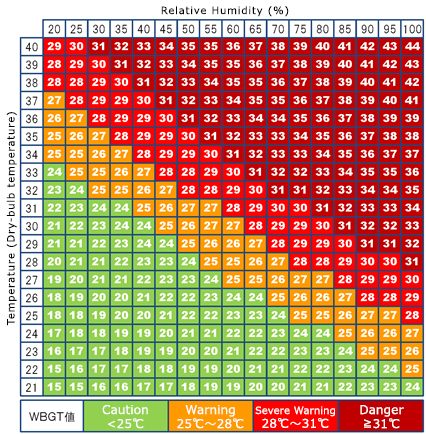Heat Index (WBGT)
Wet Bulb Globe Temperature (WBGT) is an environmental index representing
It has been specified as a heat illness risk on the Japanese Ministry of the Environment’s heat illness prevention website since 2006.
WBGT is calculated from dry bulb temperature, wet bulb temperature and globe temperature.
*1 Radiation heat comes from the ground, buildings, people and other sources. Hotter bodies emit larger amounts.
*2 Wind also affects human heat balance.
Guideline
| Air temperature (typical value) | WBGT | Guides to how much exercise can be safely performed | |
|---|---|---|---|
| ≥ 35 ℃ | ≥ 31 ℃ | Danger(exercise prohibited) | At a WBGT of 31 ℃ or above the actual temperature is higher than the skin temperature, so body heat cannot escape, and except for special cases, all exercise should be stopped. |
| 31 - 35 ℃ | 28 - 31 ℃ | Severe Warning (heavy exercise prohibited) |
At a WBGT of above 28 ℃ the danger of heatillness is high, so events that require heavy exercise or events where the body temperature will rise, like endurance races should be avoided. When such events are held, rest periods should be provided often and water replenishment conducted aggressively. People who are weak or not used to the heat should stop the exercise. |
| 28 - 31 ℃ | 25 - 28 ℃ | Warning (rests should be provided often) |
At a WBGT of above 25 ℃ the danger of heatillness increases, so rest periods should be provided often and water replenishment conducted. Rest periods should be provided every 30 minutes for events requiring heavy exercise. |
| 24 - 28 ℃ | 21 - 25 ℃ | Caution (water should be replenished often) |
At a WBGT of above 21 ℃ there is the danger of fatal accidents due to heatillness, so caution is advised, and water replenishment should be promoted during exercise. |
| < 24 ℃ | 未滿21℃ | Almost safe (appropriate water replenishment suggested) |
At a WBGT below 21 ℃ normally the danger of heatillness is small, but appropriate water replenishment is necessary. Heatillness can occur even under these conditions in events such as citizen marathons, so caution is advised. |
Reference: Japan Sports Association, "A Guidebook for the Prevention of Heat Disorder During Sports Activities", 2013.
WBGT values and its relation with the temperature and relative humidity

(28℃-31℃ means 28℃ or higher than 28℃ and lower than 31℃ here.)
(Excerpt from the “Guideline for Prevention of Heat Strokes in Daily Life” Ver.1 in April 2008 prepared by Japanese Society of Biometeorology)
*The above classification such as danger and extreme caution is the standard in daily life and it doesn’t apply to the standard in workplaces.





